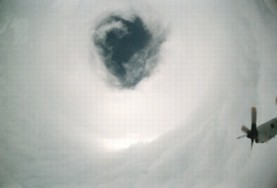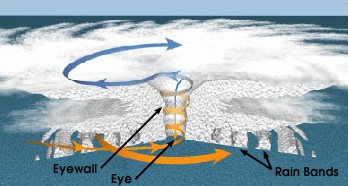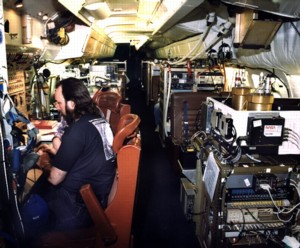|
Flying into the largest storms on Earth is
all in a day's work for pilots on a NASA mission to explore hurricanes.
by Steve Price and Patrick
L. Barry
It's a rather daunting job description:
"Multi-engine aircraft pilot, substantial experience required, must
be willing to fly into hurricanes."
But some pilots with NASA's Convection And Moisture Experiment (CAMEX-4)
do exactly that. With eyes wide open they deliberately fly over, around,
and even into the biggest storms on Earth.
These unusual aviators endure the dangers
of flying through hurricanes in the hope that scientific data they
collect will improve hurricane modelling and prediction, which in
turn might help save property and lives. Instruments aboard the
planes measure temperature, pressure, humidity, precipitation, wind
speed, lightning and ice crystal sizes - providing scientists with
a hard-won view of the inner workings of a hurricane.
"You pass through this build-up of
clouds that literally fills the sky in front of you," said Gordon
Fullerton, a highly decorated aviator and former astronaut who pilots
a DC-8 aircraft into hurricanes targeted by the CAMEX-4 study.
"Entering the storm, we're faced with rotating bands of thunderstorms
as we fly at about 35,000 feet. A hurricane is just a group of thunderstorms
circulating around a point called the 'eye.' You can pass through
the eye and experience a calm as you observe thunderstorms circling
all around you," Fullerton said.
It may be true that the eye of the storm is cloudless and less windy
than the rest of the tempest - but only someone like Fullerton with
plenty of experience (and perhaps nerves of steel) could feel
calm surrounded by most intense thunderstorms in the whole hurricane.
It's a dangerous place to fly an airplane!
How do the pilots safely navigate these
powerful hazards?

Visit Dommin's photo
gallery for more such spectacular views or HurricaneHunters.com
to learn more about the daring pilots who pioneered
the dangerous art of flying into great storms.
This view,
looking straight up through the eye of a hurricane, was captured
by navigator Scott A. Dommin - one of the US Air Force's
famous "Hurricane Hunters."
|
Simply looking out of the cockpit window
is one way. Because a hurricane is a collection of thunderstorms,
pilots can often visually spot the stronger storms and simply avoid
them. For example, says Fullerton, "If I see a thunderstorm that climbs
up to 60,000 ft., I can tell by its thickness and blackness that I
don't want to go in there."
Clouds can make such visual spotting
difficult, however. "If we encounter a lot of cirrus clouds, we're
stuck with just the radar," Fullerton said. The DC-8 pilots can
direct their Doppler radar's up and down the storm scanning for
trouble.
"These storms can be very rough," Fullerton said. "We can experience
strong turbulence as well as rapid accumulation of ice crystals,
something scientists call 'graupel.' And large hailstones can terribly
damage the aircraft."
"It's also noisy," he added. "All the precipitation begins pounding
on the windshield. It compares with driving your car fast through
a heavy thunderstorm, with the difference being we're above 30,000
ft."
The pilots sometimes pass through strong
vertical winds that accelerate the plane downward and then upward.
These intense gusts can toss the pilots "up against their straps."
| |

Image courtesy NOAA. |
Hurricanes
form as warm, humid air rises, causing the moisture to condense
out, which releases heat into the air and causes it to rise
still faster in an accelerating cycle. This forms the tall,
billowing thunderstorms and also leaves an area of low pressure
near the surface. Surrounding air is drawn toward this low
pressure, spiralling in toward the centre due to the Coriolis
effect. The rising air also creates a high-pressure area
at high altitude, which causes an outward spiralling of
clouds high above the main storm clouds.
|
"Depending on the level of turbulence,
it can be structurally significant to the airplane," said Fullerton,
who said the heavier turbulence can surprise even seasoned pilots.
"When you reach turbulence and the coffee flies out of your cup....
[well,] that's when we turn the aircraft toward an area where radar
indicates the conditions are better."
Encountering a severe storm within a hurricane can be quite an experience!
While Fullerton's DC-8 ventures into
the storm, ER-2 pilots fly high above it - at the very edge of
space! The ER-2, a civilian version of the U-2 military spy plane,
soars to 60,000 feet where instruments can record both the height
and girth of the storm.
"One of the reasons that the ER-2 is such a unique platform is the
instruments are basically the same as on the satellites in outer
space," said Jan Nystrom, an ER-2 pilot with Lockheed. Only the
ER-2 is much closer to the storm than orbiting satellites. "We are
the close-up lens."
The view from the dizzying height of 60,000 ft. is "definitely something
you're not used to. We're kind of in the twilight zone there," he
laughed. "The sky above you is much darker because we are above
about 90 to 95 percent of the Earth's atmosphere."
From their high perch, ER-2 pilots get a different view of the hurricane's
eye than the DC-8 crew.

NASA's ER-2
research aircraft is an elegant-looking plane, and its resemblance
to the famous U-2 is no coincidence - the ER-2 is a civilian
version of the military spy plane. [more]
|
"Depending on how well-defined the
eye of the hurricane is, you can sometimes look down all the way
through the storm and see blue water," Nystrom said.
A single pilot flies the ER-2 aircraft,
which is 63 ft. long with a wingspan of 104 ft. These long, thin
wings give the plane a maximum altitude of about 65,000 ft., and
its light weight enables it to have a range of 3,000 nautical miles
(about 3,452 miles or 5,555 km).
"It really amounts to a high-altitude jet glider," said Larry Montoya,
mission manager for the ER-2.
All pilots flying the ER-2 missions received previous experience
with the aircraft during stints with the military. These aviators
are well aware of the dangers involved and actually are outfitted
with spacesuits just like the astronauts use.

Image courtesy NASA's
Dryden Flight Research Centre
NASA's DC-8
research aircraft may look like a commercial airliner from
the outside, but the inside is a different story! The interior
of the plane has been converted into a flying laboratory filled
with data-gathering scientific equipment. With the lives of
the scientists who operate the instruments also at stake,
the DC-8 pilots must be extra-cautious.
|
The cabin is pressurised to about 28,000
ft.," said Nystrom. "However, if we should lose cabin pressure for
any variety of reasons, then the pressure would drop to ambient pressure.
If we didn't have that suit to protect us, our blood would boil ....
it would be fatal."
The majority of these missions are flown high above the destruction
the storm unleashes at ground level, but the storms right around the
eye can sometimes extend all the way up to the altitudes where the
ER-2 flies. "When we experience moderate to strong turbulence, we
tend to get away from that," Nystrom said.
Mission rules are followed closely,
especially regarding turbulence, where pilots are instructed to
escape the area before the situation gets out of hand.
"These rules are driven, basically, by the capabilities of the airplane,"
Montoya said. It's a situation where following the rules is very
important! With the proper caution and equipment, these skilful
pilots are able to do their seemingly treacherous jobs safely, collecting
vital data from inside the largest storms on Earth.
|
